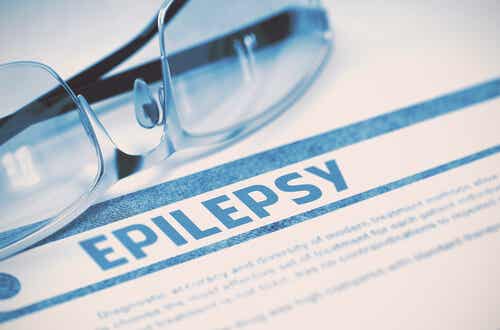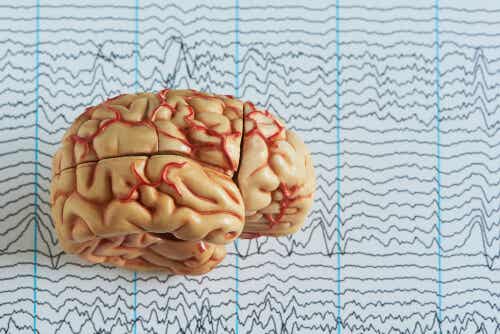Performance and Effects of Antiepileptic Drugs

Antiepileptic drugs are the main treatment for epilepsy. Continue reading to learn more about this disease. This article will describe what it’s all about, as well as the various forms of treatment.
Epilepsy is a chronic disorder of the central nervous system that alters brain activity. It manifests as epileptic seizures with convulsions.
In order for this condition to be diagnosed, the patient must have had at least two seizures. An isolated episode is just a symptom of a given condition. It may be caused by a specific abnormal functioning of neurons, but seldom repeats.
An epileptic episode can have different symptoms. These are some of the most common:
- Spasmodic movements.
- Confusion.
- Absences.
- Loss of consciousness.
Therefore, one can define epilepsy as a brain disorder that predisposes to epileptic seizures and has associated physical, psychological, and social consequences. The prevalence of this disease in the population is between 0.4 and 0.8 percent.
The incidence is 50 new cases per 100,000 inhabitants per year. Although it can affect any person of any sex and any age, it’s more common in babies and older people.

Epileptic seizures
One can classify these into two main groups, which, in turn, divide into further subtypes:
- Focal or partial seizures are those caused by abnormal activity in a specific area of the brain. They further divide into:
- Simple. Those that don’t lead to loss of consciousness.
- Complex. Those in which there’s a loss of consciousness.
- Generalized seizures are those that occur in all areas of the brain. Generalized seizures, in turn, break down into:
- Absence. The gaze remains fixed for a few seconds and body movements such as rapid blinking or lip-smacking occur.
- Tonic. There’s muscular rigidity.
- Atonic. The muscles relax so there’s no muscle control; it often leads to falls.
- Clonic. Repetitive tremors or jerks in various parts of the body.
- Myoclonic. Short brief and sudden jerking movements in various parts of the body.
- Tonic-clonic. These are the most intense seizures and may cause sudden loss of consciousness, muscle spasms, stiffness, and screaming, among others.
How do antiepileptic drugs work?
Antiepileptic drugs are the basic treatment for patients with epilepsy. Their goal is to restore neuronal balance in order to prevent the onset of epileptic seizures or, at least, to control them. There are different mechanisms by which these drugs modulate neuronal excitability. These are the two main mechanisms:
- Activation of the GABA inhibitory system, the neurotransmitter responsible for inhibiting neuronal activation.
- Inhibition of the excitatory glutamate system, the main excitatory neurotransmitter that activates neuronal processes in the brain.
Specifically, neurons either activate or inhibit depending on their electrical potential difference. In other words, there are ion channels in the neuronal membrane that modulate neuronal activity by allowing, or not, ions to pass through them. Many of the antiepileptic drugs act on these voltage-dependent ion channels.
Types of antiepileptic drugs
There are many different antiepileptic drugs. Not all of them work in all patients in the same way. Nor are the adverse effects the same. Specialists must study every case individually in order to prescribe the treatment best suited to a patient’s specific needs. Depending on their structure, one can classify antiepileptic drugs as follows:
- Hydantoins, such as phenytoin.
- Barbiturates, such as phenobarbital.
- Iminostylbenes, such as carbamazepine.
- Benzodiazepines, such as diazepam.
- Valproic acid.
- Others, such as gabapentin or topiramate.
Another classification divides antiepileptics into:
- Classical antiepileptics:
- First-generation, such as phenobarbital or phenytoin.
- Second-generation, such as carbamazepine, valproic acid, and benzodiazepines.
- New antiepileptics, such as gabapentin and lamotrigine.
- Others, such as oxcarbamazepines and topiramate.
According to their mechanism of action, one can also classify them as:
- Na channel inhibitors such as carbamazepine, oxcarbamazepine, phenytoin, and lamotrigine.
- Drugs acting on GABA receptors such as benzodiazepines, barbiturates, valproic acid, and gabapentin.
- Drugs acting on glutamate receptors like topiramate.

Side effects
The most common side effects of antiepileptic drugs are:
- Drowsiness and dizziness.
- Headache.
- Gastrointestinal symptoms.
- Difficulty concentrating.
- Mood disturbance.
- Blurred vision.
The patient must follow their doctor’s guidelines to avoid the appearance of unwanted side effects. The patient must always take the drugs at the same time and not interrupt them abruptly. Treatment with antiepileptic drugs requires control and monitoring by the attending physician on a regular basis.
Interactions of antiepileptic drugs with other drugs and substances are common. Thus, you should always consult your doctor before self-prescribing any of them or taking any nutritional supplements and similar compounds.
All cited sources were thoroughly reviewed by our team to ensure their quality, reliability, currency, and validity. The bibliography of this article was considered reliable and of academic or scientific accuracy.
- Organización Mundial de la Salud. (2016). OMS | Epilepsia. WHO.
- Ibáñez, V., & Aguilar-Amat, M. J. (2011). Tratamiento de la epilepsia. Medicine.
- Herranz Fernández, J. L. (2019). Fármacos antiepilépticos. Revista de Neurología.
This text is provided for informational purposes only and does not replace consultation with a professional. If in doubt, consult your specialist.








